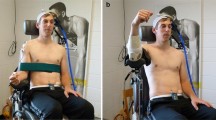Abstract
Introduction
Previous EMG studies have shown that chronic rotator cuff tears (RCT) may be associated with an altered activation of adjacent shoulder muscles. The effect of RCT on central neuromuscular control mechanisms of hand muscles has as yet not been studied in detail. This study investigated the cortico-motor excitability of the first dorsal interosseus muscle (FDI) in patients with RCT.
Materials and methods
The resting motor threshold (RMT) of the FDI on both sides were obtained from patients with unilateral chronic RCT and compared with healthy control subjects without any shoulder pathologies with transcranial magnetic stimulation. Analysis of variance for repeated measures was performed to detect possible differences in RMT of the FDI in patients and healthy controls.
Results
The RMT of FDI in patients on the affected side was lower when compared to the non-affected side (p = 0.015) and to both sides in control subjects (p = 0.041, F = 4.8).
Conclusions
The reduced RMT of FDI in patients with unilateral RCT may be related to alterations in the sensory output from the shoulder and points toward a complete sensimotor restriction of the involved upper limb. These findings seem to be assigned to adaptive changes in the motor cortex as a consequence of chronic RCT.


Similar content being viewed by others
References
Abbruzzese G, Trompetto C (2002) Clinical and research methods for evaluating cortical excitability. J Clin Neurophysiol 19(4):307–321
Awiszus F (2003) TMS and threshold hunting. Suppl Clin Neurophysiol 56:13–23
Awiszus F (2005) Quantification of motoneurone pool responses to transcranial magnetic stimulation with surface electromyography. Biocybern Biomed Eng 25(3):3–10
Barker AT, Jalinous R, Freeston IL (1985) Non-invasive magnetic stimulation of human motor cortex. Lancet 1(8437):1106–1107
Berth A, Pap G, Awiszus F (2009) Zentrales Aktivierungsdefizit des M. deltoideus bei traumatischer Schulterinstabilität. Obere Extremität 4(1):16–22
Berth A, Pap G, Neumann W, Awiszus F (2009) Central Neuromuscular Dysfunction Of The deltoideus muscle in patients with chronic rotator cuff tears. J Orthopaed Traumatol (in press)
Bryden MP (1977) Measuring handedness with questionnaires. Neuropsychologia 15(4–5):617–624
Constant CR, Murley AH (1987) A clinical method of functional assessment of the shoulder. Clin Orthop Relat Res (214):160–164
Devanne H, Cassim F, Ethier C, Brizzi L, Thevenon A, Capaday C (2006) The comparable size and overlapping nature of upper limb distal and proximal muscle representations in the human motor cortex. Eur J Neurosci 23(9):2467–2476
Devanne H, Cohen LG, Kouchtir-Devanne N, Capaday C (2002) Integrated motor cortical control of task-related muscles during pointing in humans. J Neurophysiol 87(6):3006–3017
Ginanneschi F, Dominici F, Biasella A, Gelli F, Rossi A (2006) Changes in corticomotor excitability of forearm muscles in relation to static shoulder positions. Brain Res 1073–1074:332–338 (Epub Feb 2)
Gohlke F (2000) Biomechanics of the shoulder. Orthopäde 29(10):834–844
Hallett M (2000) Transcranial magnetic stimulation and the human brain. Nature 406(6792):147–150
Heroux ME, Tremblay F (2006) Corticomotor excitability associated with unilateral knee dysfunction secondary to anterior cruciate ligament injury. Knee Surg Sports Traumatol Arthrosc 14:823–833
Hudak PL, Amadio PC, Bombardier C (1996) Development of an upper extremity outcome measure: the DASH (disabilities of the arm, shoulder and hand) [corrected]. The Upper Extremity Collaborative Group (UECG). Am J Ind Med 29(6):602–608
Kelly BT, Williams RJ, Cordasco FA, Backus SI, Otis JC, Weiland DE, Altchek DW, Craig EV, Wickiewicz TL, Warren RF (2005) Differential patterns of muscle activation in patients with symptomatic and asymptomatic rotator cuff tears. J Shoulder Elbow Surg 14(2):165–171
Malcolm MP, Triggs WJ, Light KE, Shechtman O, Khandekar G, Gonzalez Rothi LJ (2006) Reliability of motor cortex transcranial magnetic stimulation in four muscle representations. Clin Neurophysiol 117(5):1037–1046
Marconi B, Pecchioli C, Koch G, Caltagirone C (2007) Functional overlap between hand and forearm motor cortical representations during motor cognitive tasks. Clin Neurophysiol 118(8):1767–1775
Murrell GA, Walton JR (2001) Diagnosis of rotator cuff tears. Lancet 357(9258):769–770
Norwood LA, Barrack R, Jacobson KE (1989) Clinical presentation of complete tears of the rotator cuff. J Bone Jt Surg Am 71(4):499–505
Scott SH (2000) Role of motor cortex in coordinating multi-joint movements: is it time for a new paradigm? Can J Physiol Pharmacol 78(11):923–933
Siebner HR, Rothwell J (2003) Transcranial magnetic stimulation: new insights into representational cortical plasticity. Exp Brain Res 148(1):1–16
Steenbrink F, de Groot JH, Veeger HE, Meskers CG, van de Sande MA, Rozing PM (2006) Pathological muscle activation patterns in patients with massive rotator cuff tears, with and without subacromial anaesthetics. Man Ther 11(3):231–237
Zanette G, Manganotti P, Fiaschi A, Tamburin S (2004) Modulation of motor cortex excitability after upper limb immobilization. Clin Neurophysiol 115(6):1264–1275
Acknowledgments
This research was supported by Deutsche Arthrose Hilfe e.V.
Author information
Authors and Affiliations
Corresponding author
Rights and permissions
About this article
Cite this article
Berth, A., Pap, G., Neumann, W. et al. Altered neuromuscular control of a hand muscle in chronic rotator cuff tears. Arch Orthop Trauma Surg 130, 705–710 (2010). https://doi.org/10.1007/s00402-009-1012-8
Received:
Published:
Issue Date:
DOI: https://doi.org/10.1007/s00402-009-1012-8




